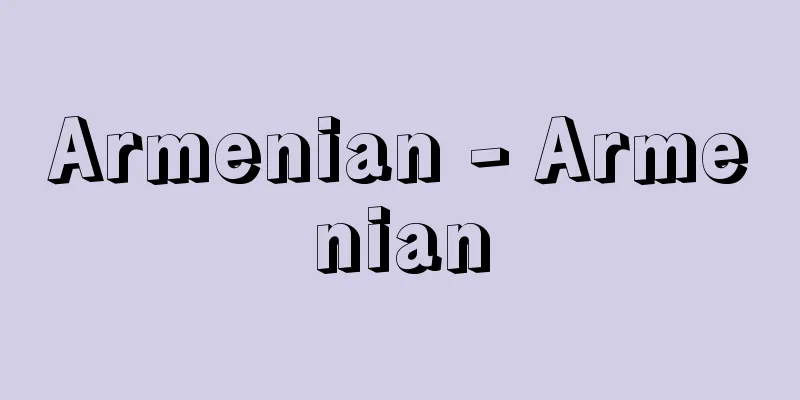Armenian - Armenian

|
It is an Indo-European language. It is the official language of the Republic of Armenia, which has a population of over 3 million, but its speakers are also distributed in neighboring countries such as Georgia, Azerbaijan, Iran, Turkey, Greece, and India. The name Armenia appears in inscriptions from the ancient Persian Empire and is also used by ancient historians, but the speakers called themselves Hay. There is a theory that this name comes from the place name Hatti, which appears in the Old Testament, but the exact reason is unknown, and it probably suggests that they migrated from somewhere in Asia Minor, as ancient historians say. This area was under the rule of foreign peoples, especially Persian dynasties, for a long time, and they were strongly influenced by them, so a large amount of Iranian vocabulary was introduced, and for a long time it was mistaken for an Iranian language. Its history begins with the translation of the Bible in the 5th century. It is written in a unique alphabet consisting of 36 letters created by a monk named Mesrop Mashtots (362-440). The documents from the middle period were left by people who migrated to Cilicia between the end of the 11th century and the 14th century and established a kingdom there. The modern language has eastern and western dialects, but the official language is based on the eastern dialect. Consonants have a series of ejectives, and nouns have no gender but seven cases. Verbs generally tend to be analytical. [Kizamaki Kiyozo] Source: Shogakukan Encyclopedia Nipponica About Encyclopedia Nipponica Information | Legend |
|
インド・ヨーロッパ語族の一語派。300万人を超えるアルメニア共和国の公用語だが、周辺のジョージア(グルジア)、アゼルバイジャン、イラン、トルコ、ギリシア、インドにまで話し手が分散している。アルメニアという名は古代ペルシア帝国の碑文に現れ、古代史家も用いているが、その話し手はハイHayと自称していた。この名称は『旧約聖書』にみる地名ハッティHattiに由来するという説もあるが、正確には不明で、おそらく古代史家の伝えるとおり、小アジアのどこからか移住してきたことを暗示するものである。この地は長く異民族、とくにペルシア系の王朝の支配下にあったためにその影響が強く、イラン系の語彙(ごい)が大量に入り、長い間イラン語の一つと見誤られていた。その歴史は5世紀の聖書訳に始まる。それはメスロプMesrop Mashtots(362―440)という僧がつくった36文字からなる独特のアルファベットによってつづられている。中期の資料は11世紀末から14世紀にキリキアに移住して王国を築いた人々の残したものである。近代語には東西の方言があるが、公用語は東方言に基づく。子音に放出音の系列があり、名詞は性はないが、7格をもつ。動詞は全体に分析的表現の傾向が強い。 [風間喜代三] 出典 小学館 日本大百科全書(ニッポニカ)日本大百科全書(ニッポニカ)について 情報 | 凡例 |
<<: Armenian - Armenian (English spelling)
>>: Armenian Church - Armenian Church
Recommend
Nagel, Ernest
Born: November 16, 1901, Nove Mesto [Died] Septemb...
Newton's Rings - Newton's Ring, Newton's Ring
When printing using an enlarger, the film is sandw...
Estigarribia, JF - Estigarribia
...World War I brought a lull, but in 1932 a bord...
Herkules Pietersz Seghers
Dutch painter and printmaker. Born in Haarlem. A ...
Boieldieu
French composer. Also known as Boiseldieu. A leadi...
Genbikei Gorge
The Iwai River Valley is located in the southwest...
Atractylodine - Atractylodine
… [Hiroshi Koyama] [Medicinal] In traditional Chi...
Small knife - Kogatana
〘Noun〙① A small sword. A small blade used for ever...
Security Council
One of the main organs of the United Nations. It ...
Brown, AW
...He died when landing at his destination), foll...
Kara Kyrgyzstan [Autonomous Region] - Kara Kyrgyzstan
...Kyrgyz factory workers were also trained, and ...
New method of paying old debts
...He left behind a wide variety of plays in diff...
Inu Ringo - Inu Ringo
…The fruit is spherical, 2-2.5cm in diameter, and...
Lesco
A representative architect of the French Renaissan...
Alaska type glacier
…Hanging glaciers are small glaciers that cling t...









